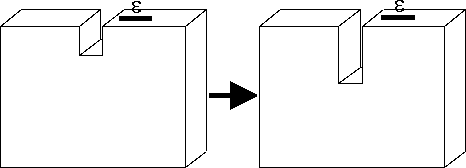|
|
|
What is the slitting (compliance) method?
About the method:

- A slot is machined incrementally into a part containing
residual stress
- The slot releases the residual stress normal to the face of the slot,
and the part deforms
- Surface strain gauges measures the resulting strains as a function
of slot depth
- The strains are then used to solve for stress as a function of
depth
See the Theory section for a graphical illustration
of how this works
If it's similar, why is it better than hole drilling in many cases?
- Put a strain gage on the back face and you can measure stresses all
the way through the thickness, not just near the surface.
- Increased "invertability" means you can measure stress variation
with depth better
- EDM machining is a very "gentle" machining
process. With hole drilling, you may introduce stresses and increase
your errors
- For further comparisons see the section on
comparing with other methods
More Detailed Information:
- Theory - How you
do the calculations
- Literature , a little
discussion on the history of the method, and some downloadable papers
- How do you make the cut? Wire
EDM (spark erosion) is one way and it makes a very thin
slot and puts in almost no stress
Where does the name come from?
The technique is named after the compliance method for measuring crack length
in fatigue specimens. There, a strain gage on the back face of the specimen
measures strain as a function of load. The slope of this line gives the
crack length.
|
|
